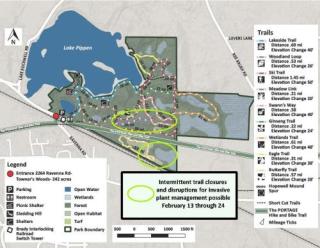Forestry Mulcher Used to Remove Invasive Shrubs at Towner's Woods

Portage Park District’s Natural Areas team has been busy out at Towner’s Woods over the last few weeks. Visitors to the park may have noticed things changing along Ski Trail and Butterfly Loop. Large infestations of non-native, invasive shrubs are being controlled using a forestry mulcher.
The Park District is a long-time member of the Crooked River Cooperative Weed Management Agreement. This cooperative is dedicated to controlling and reducing invasive plant populations throughout the Cuyahoga River watershed by sharing staff, knowledge, resources, and equipment, such as the forestry mulcher being used at Towner’s Woods. The vegetation being cleared consists of non-native, invasive shrubs and vines. These primarily include multiflora rose, Oriental bittersweet, glossy buckthorn, tree of heaven, bush honeysuckle, and autumn olive, to name a few. Between Ski Trail and Meadow Link, these plants have dominated the site to a point that the natural succession of native forest species had been severely hindered. The goal of this work is to reduce the populations of invasive shrubs and reduce their continued spread into the adjacent mature, native forest habitats at Towner’s Woods. In addition, the removal of these plants serves to foster the site’s long-term succession to a mature, native forest. Thankfully, there are promising patches of great native shrubs and trees within the site, which have been avoided with the mulcher. Native woody plants spared include gray dogwood, black elderberry, wild black cherry, and oak, along with several others.
By removing the non-native plants, the native species will now have the opportunity to spread, thrive and establish over the site. Many of the mulched non-native plants may still send up stump sprouts, but these will be much more manageable as we complete manual follow-up treatments in the coming growing seasons. In the near term, a temporary grass cover will be seeded across the site as we continue to control the non-native woody plants.
Just east of Butterfly Loop and south of the PORTAGE Hike and Bike Trail, the same invasive shrubs are being controlled with the mulcher. In this area, the goals include not only the reduction of invasive plants but also to promote the succession of the plant community to a meadow stage. Maintaining an open, herbaceous meadow provides a valuable habitat component for birds, pollinators, and many other wildlife species. It also helps us to maintain populations of native warm-season grasses and forbs that have historically occurred on the site.
Conservation is at the forefront of the Portage Park District mission. As with any land management practice at the Park District, we always maintain an awareness of how much of a particular habitat we are affecting in terms of habitat structure. Regardless of species composition, many wildlife species utilize any given habitat structure. Both areas we are working in are in a mid-successional growth stage. A similar habitat structure still occurs within Towner’s Woods, and we have been mindful in our work to avoid depleting this habitat as a resource for wildlife. This type of land resource management helps to protect and restore native habitats for our wildlife and for the health and enjoyment of our community in the future.

